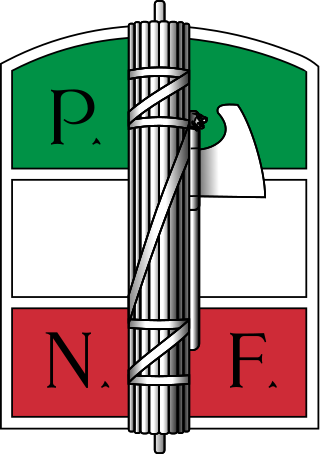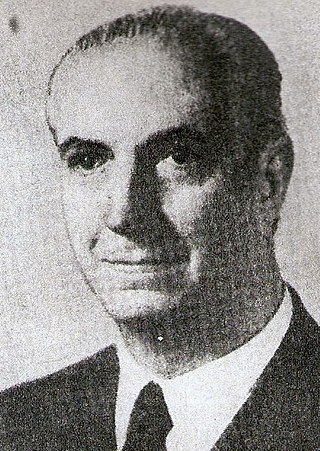
Nacionalismo was a far-right Argentine nationalist movement that around 1910 grew out of the "traditionalist" position, which was based on nostalgia for feudal economic relations and a more "organic" social order. It became a significant force in Argentine politics beginning in the 1930s. Nacionalismo was typically centred upon the support of order, hierarchy, a corporative society, militant Catholicism, and the landed estates (latifundia), combined with the hatred of liberalism, leftism, Freemasonry, feminism, Jews and foreigners. It denounced liberalism and democracy as the prelude to communism. The movement was also irredentist, declaring intentions to annex Uruguay, Paraguay, Chile and some southern and eastern parts of Bolivia and even the British-held territory of the Falkland Islands and its dependencies.

The Party of the Reconstruction of the National Order was a nationalist political party in Brazil. Its electoral code was 56 and its colors were the traditional Brazilian green and yellow. It was founded in 1989 by the cardiologist, professor and politician Enéas Carneiro, who was the president of the party. Its political broadcasts during the pre-election campaigning periods became famous and distinct for the speed in which they were produced due to the very short time the party had available and also because of the use of Beethoven's Fifth Symphony as soundtrack.

Alceu Amoroso Lima was a writer, journalist, activist from Brazil, and founder of the Brazilian Christian Democracy. He adopted the pseudonym Tristão de Ataíde in 1919. In 1928 he converted to Catholicism and eventually became head of Catholic Action in Brazil. Although he initially had some sympathy for certain aims of Brazilian integralism he became a strong opponent of authoritarianism in general and Fascism in particular. That came in part through the influence of Jacques Maritain. He was a staunch advocate for press freedom during the period of military dictatorship.

The National Fascist Party was a political party in Italy, created by Benito Mussolini as the political expression of Italian fascism and as a reorganisation of the previous Italian Fasces of Combat. The party ruled the Kingdom of Italy from 1922 when Fascists took power with the March on Rome until the fall of the Fascist regime in 1943, when Mussolini was deposed by the Grand Council of Fascism. It was succeeded, in the territories under the control of the Italian Social Republic, by the Republican Fascist Party, ultimately dissolved at the end of World War II.

The Falange Española Tradicionalista y de las Juntas de Ofensiva Nacional Sindicalista, frequently shortened to just "FET", was the sole legal party of the Francoist regime in Spain. It was created by General Francisco Franco in 1937 as a merger of the fascist Falange Española de las JONS with the monarchist neo-absolutist and integralist Catholic Traditionalist Communion belonging to the Carlist movement. In addition to the resemblance of names, the party formally retained most of the platform of FE de las JONS and a similar inner structure. In force until April 1977, it was rebranded as the Movimiento Nacional in 1958.
Fascism in South America encompasses an assortment of political parties and movements modeled on fascism. Although the ideology originated in and is primarily associated with Europe, fascism crossed the Atlantic Ocean in the interwar period and had an influence on South American politics. Italian fascism had a deep impact in the region, both directly and indirectly.
Rodolfo Irazusta was an Argentine writer and politician who was one of the leading lights of the nationalist movement of the 1920s and 1930s. He collaborated closely with his younger brother Julio Irazusta throughout his career.

Julio Alberto Gustavo Irazusta was an Argentine writer and politician who was one of the leading lights of the nationalist movement of the 1920s and 1930s. He collaborated closely with his older brother Rodolfo Irazusta throughout his career.
Juan Emiliano Carulla was an Argentine physician and nationalist politician. He was most prominent under the military regime in power during the early 1930s.

Father Julio Meinvielle was an Argentine priest and prolific writer. A leading Roman Catholic Church thinker of his time, he was associated with the far right tendency within Argentine Catholic thinking. As a polemicist he had a strong influence on the development of nacionalismo.

Mario Octavio Amadeo was an Argentine conservative nationalist politician, diplomat and writer who served as a minister in the government of Eduardo Lonardi. He belonged to the highly influential right-wing tendency prominent in Argentine politics either side of the Second World War.

Nimio de Anquín (1896–1979) was an Argentine Thomist writer and fascist politician. Seeking to combine European models of fascism with his own attachment to the Catholic Church he led several movements and for a time had a strong following. Subsequently, however, he lost political influence, and his later life was mainly focused on his academic career.
The Mexican Fascist Party was a very minor political party founded in Mexico City in December of 1922 by Gustavo Sáenz de Sicilia. Officially based upon Italian Fascism, the party members drafted a manifesto entitled Manifiesto del Partido Fascista Mexicano a la Nación.

The National Fascist Party of Argentina was a fascist political party that was formed in 1923.

The National Fascist Union was a fascist political party formed in Argentina in 1936, as the successor to the Argentine Fascist Party.
Roberto de Laferrère was an Argentinean writer and political activist. He was one of the leading figures in the nationalist movement active amongst a group of leading intellectuals in the 1930s.

Colegio Nacional de Monserrat is a public college preparatory high school in Córdoba, Argentina. Patterned after the European gymnasium, the school is the second oldest of its type and one of the most prestigious in Argentina.
The Republican League was a fascist movement in Argentina founded by Roberto Laferrere and Rodolfo Irazusta in 1929. The party borrowed heavily from the ideology and structure of the French integrist movement Action Française whose ideas had been disseminated in Argentina by polemicists such as Juan Carulla.

Brigadier General Juan Bautista Molina was an Argentine military commander and a pro-Nazi Argentine ultranationalist who led the Nationalist Liberation Alliance (ALN).

The Nationalist Liberation Alliance, originally known as the Argentine Civic Legion from 1931 to 1937, the Alliance of Nationalist Youth from 1937 to 1943, and then using its final name from 1943 to 1955, was a Nacionalista and fascist movement.














